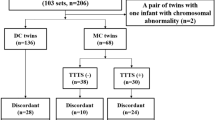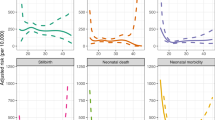Abstract
Objective
Examine outcomes among birth weight concordant and discordant 401–1500 g twins.
Study design
Twins (n = 8,114) at NICHD Neonatal Research Network (1994–2011) were studied. Discordance (birth weight difference/larger twin birth weight x 100%) was categorized into: ≤ 14, > 14–20, > 20–30, and > 30%. Separate logistic regression models for the smaller and larger infants assessed the adjusted association between discordance and outcomes.
Results
Compared with the smaller twin with ≤ 14% discordance, mortality, necrotizing enterocolitis, severe retinopathy of prematurity, bronchopulmonary dysplasia, and neurodevelopmental impairment or death were highest among the smaller twins with discordance > 30%. The larger twins with discordance > 30% had higher odds of patent ductus arteriosus, moderate-to-severe cerebral palsy, blindness, cognitive and motor scores < 70. Odds of cerebral palsy and blindness were also higher among the larger twins with discordance > 14–20%.
Conclusions
Discordance > 30% was associated with higher mortality in the smaller twin and higher morbidities among the smaller and larger twins.
This is a preview of subscription content, access via your institution
Access options
Subscribe to this journal
Receive 12 print issues and online access
$259.00 per year
only $21.58 per issue
Buy this article
- Purchase on Springer Link
- Instant access to full article PDF
Prices may be subject to local taxes which are calculated during checkout

Similar content being viewed by others
References
Miller J, Chauhan SP, Abuhamad AZ. Discordant twins: diagnosis, evaluation and management. Am J Obstet Gynecol. 2012;206:10–20.
Vergani P, Locatelli A, Ratti M, Scian A, Pozzi E, Pezzullo JC, et al. Preterm twins: what threshold of birth weight discordance heralds major adverse neonatal outcome? Am J Obstet Gynecol. 2004;191:1441–5.
Amaru RC, Bush MC, Berkowitz RL, Lapinski RH, Gaddipati S. Is discordant growth in twins an independent risk factor for adverse neonatal outcome? Obstet Gynecol. 2004;103:71–6.
Kilic M, Aygun C, Kaynar-Tuncel E, Kucukoduk S. Does birth weight discordance in preterm twins affect neonatal outcome? J Perinatol. 2006;26:268–72.
Talbot GT, Goldstein RF, Nesbitt T, Johnson JL, Kay HH. Is size discordancy an indication for delivery of preterm twins? Am J Obstet Gynecol. 1997;177:1050–4.
ACOG Practice Bulletin #56. Multiple gestation: complicated twin, triplet, and high-order multifetal pregnancy. Obstet Gynecol. 2004;104:869–83.
Alexander GR, Himes JH, Kaufman RB, Mor J, Kogan M. A United States national reference for fetal growth. Obstet Gynecol. 1996;87:163–8.
Walsh MC, Kliegman RM. Necrotizing enterocolitis: treatment based on staging criteria. Pedia Clin North Am. 1986;33:179–201.
Papile LA, Burstein J, Burstein R, Koffler H. Incidence and evolution of subependymal and intraventricular hemorrhage: a study of infants with birth weights less than 1,500 gm. J Pediatr. 1978;92:529–34.
WHO Multicentre Growth Reference Study Group. WHO Child Growth Standards: methods and development: Head circumference-for-age, arm circumference-for-age, triceps skinfold-for-age and subscapular skinfold-for-age. Geneva: World Health Organization; 2007.
WHO Multicentre Growth Reference Study Group. WHO Child Growth Standards: methods and development: Length/height-for-age, weight-for-age, weight-for-length, weight-for-height and body mass index-for-age. Geneva: World Health Organization; 2006.
Grantz KL, Grewal J, Albert PS, Wapner R, D’Alton ME, Sciscione A, et al. Dichorionic twin trajectories: the NICHD Fetal Growth Studies. Am J Obstet Gynecol. 2016;215:221.
Blickstein I, Shoham-Schwartz Z, Lancet M, Borenstein R. Characterization of the growth-discordant twin. Obstet Gynecol. 1987;70:11–5.
O’Brien WF, Knuppel RA, Scerbo JC, Rattan PK. Birth weight in twins: an analysis of discordancy and growth retardation. Obstet Gynecol. 1986;67:483–6.
Yinon Y, Mazkereth R, Rosentzweig N, Jarus-Hakak A, Schiff E, Simchen MJ. Growth restriction as a determinant of outcome in preterm discordant twins. Obstet Gynecol. 2005;105:80–4.
Sannoh S, Demissie K, Balasubramanian B, Rhoads GG. Risk factors for intrapair birth weight discordance in twins. J Matern Fetal Neonatal Med. 2003;13:230–6.
Kim LH, Caughey AB, Yee LM, Cheng YW. Association between the degree of twin birthweight discordance and perinatal outcomes. Am J Perinatol. 2018; epub ahead of print Nov 26; https://doi.org/10.1055/s-0038-1675769.
Blickstein I, Keith LG. Neonatal mortality rates among growth-discordant twins, classified according to the birth weight of the smaller twin. Am J Obstet Gynecol. 2004;190:170–4.
Cooperstock MS, Tummaru R, Bakewell J, Schramm W. Twin birth weight discordance and risk of preterm birth. Am J Obstet Gynecol. 2000;183:63–7.
Erkkola R, Ala-Mello S, Piiroinen O, Kero P, Sillanpaa M. Growth discordancy in twin pregnancies: a risk factor not detected by measurements of biparietal diameter. Obstet Gynecol. 1985;66:203–6.
Hollier LM, McIntire DD, Leveno KJ. Outcome of twin pregnancies according to intrapair birth weight differences. Obstet Gynecol. 1999;94:1006–10.
Tan H, Wen SW, Fung Kee FK, Walker M, Demissie K. The distribution of intra-twin birth weight discordance and its association with total twin birth weight, gestational age, and neonatal mortality. Eur J Obstet Gynecol Reprod Biol. 2005;121:27–33.
Branum AM, Schoendorf KC. The effect of birth weight discordance on twin neonatal mortality. Obstet Gynecol. 2003;101:570–4.
Demissie K, Ananth CV, Martin J, Hanley ML, MacDorman MF, Rhoads GG. Fetal and neonatal mortality among twin gestations in the United States: the role of intrapair birth weight discordance. Obstet Gynecol. 2002;100:474–80.
Jahanfar S, Lim K, Oviedo-Joekes E. Optimal threshold for birth weight discordance: Does knowledge of chorionicity matter? J Perinatol. 2016;36:704–12.
Rydhstroem H. The relationship of birth weight and birth weight discordance to cerebral palsy or mental retardation later in life for twins weighing less than 2500 grams. Am J Obstet Gynecol. 1995;173:680–6.
Adegbite AL, Castille S, Ward S, Bajoria R. Prevalence of cranial scan abnormalities in preterm twins in relation to chorionicity and discordant birth weight. Eur J Obstet Gynecol Reprod Biol. 2005;119:47–55.
Edmonds CJ, Isaacs EB, Cole TJ, Rogers MH, Lanigan J, Singhal A, et al. The effect of intrauterine growth on verbal IQ scores in childhood: a study of monozygotic twins. Pediatrics. 2010;126:e1095–101.
Acknowledgements
See Supplement B.
Funding:
Supported by the Eunice Kennedy Shriver National Institute of Child Health and Human Development (NICHD).
Author information
Authors and Affiliations
Consortia
Corresponding author
Ethics declarations
Conflict of interest
The authors declare that they have no conflict of interest.
Additional information
Publisher’s note: Springer Nature remains neutral with regard to jurisdictional claims in published maps and institutional affiliations.
Supplementary information
Rights and permissions
About this article
Cite this article
Boghossian, N.S., Saha, S., Bell, E.F. et al. Birth weight discordance in very low birth weight twins: mortality, morbidity, and neurodevelopment. J Perinatol 39, 1229–1240 (2019). https://doi.org/10.1038/s41372-019-0427-5
Received:
Revised:
Accepted:
Published:
Issue Date:
DOI: https://doi.org/10.1038/s41372-019-0427-5
This article is cited by
-
Association between fetal growth-restriction and retinopathy of prematurity using a unique identical twin model
Pediatric Research (2023)
-
Assessment of different thresholds of birthweight discordance for early neonatal outcomes: retrospective analysis of 2348 twin pregnancies
BMC Pregnancy and Childbirth (2022)
-
Antenatal exposure to fenoterol is not associated with the development of retinopathy of prematurity in infants born before 32 weeks of gestation
Archives of Gynecology and Obstetrics (2020)



